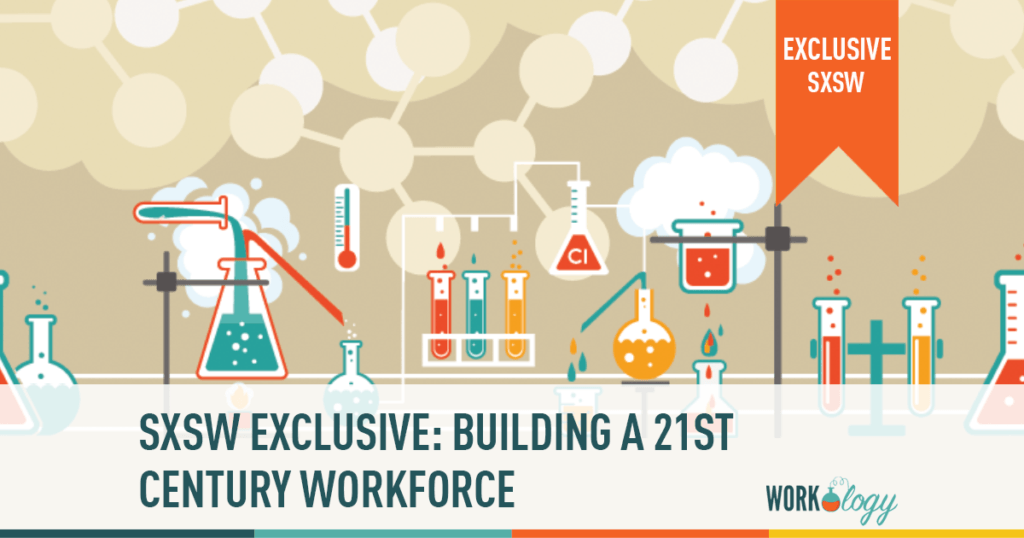I’ve been thinking a lot about my 10-year-old daughter and how her future job and career has likely not been developed yet. I encourage her to participate in technology development (she recently created her own website, says the proud mom), but I can’t say for certain how the skills she’s learning today will be relevant for her future. The panel session at SXSW 2019 on Building a 21st Century Workforce couldn’t have been more timely. How do we train our current and future workforce on jobs that have been invented yet, while also planning our own HR and business forecasting?
The fact is, how we work has changed dramatically in just the past decade. We’re operating in a near-zero unemployment economy, we’ve been introduced to the gig economy, Boomers are retiring in droves and the skills gap is widening. As HR leaders, there are some areas we can focus on now that can help us with a predictive model for what our future workplace will look like.
Investing in STEM for Future Employees and Candidates
The Bureau of Labor Statistics says we’ll need nine million STEM workers by 2022 to fill growing demand in the tech economy. By investing in STEM education, we can introduce today’s students—our current and future workers—to opportunities in the new economy.
Despite the efforts we’ve made in the U.S. over the past several years, girls and young women remain less likely to pursue education and careers in STEM, according to a 2018 report from Microsoft. The report, Closing The STEM Gap, has data on the gap between the perceptions and realities of girls and young women contemplating their roles in STEM careers and the educational experiences required to build STEM competencies.
According to Microsoft’s research, over 75% of girls who participate in hands-on STEM activities outside the classroom feel a sense of empowerment. That finding drops to under 50% for those who only experience STEM activities in the classroom. Many students are finding external opportunities to collaborate through real-world challenges. This means that a focus on getting a traditional four-year college degree may not always be the best option for every student. Offering opportunities like apprenticeships, internships and training programs that give hands-on, real-world experience combined with a two-year degree, or no college degree at all (given the student loan debt crisis we’re currently experience) seem to be a logical step.
Automation, Artificial Intelligence, and the Changing Nature of Jobs
Earlier this year, I had the opportunity to interview Peter Weddle for the Workology Podcast. Weddle is an innovator in the HR and job search space. He’s published multiple books including his most recent, “Circa 2118: What Humans Will Do When Machines Take Over.” He’s also the CEO of TA Tech. In podcast episode 168: How Robots Will Change Our Workplace, we discussed how the world will be changing as a result of robots, artificial intelligence, and other types of technology.
Weddle talked about his book, but also cites some really intriguing research to support how quickly tech is being adopted. A report from Boston Consulting Group reports that up 23% of all industrial tasks will be automated by robots by the year 2025 and P.W. C. says that 38% of all jobs will be automated just five years after that by 2030. These adoption rates in our workplaces of technology combined with the likelihood that employees will be shifting to different jobs and areas of the business put HR in a unique position to really be the champion of change. And the opportunity for HR to become a leader in the workplace when it comes to the AI conversation means educating ourselves on these topics so that we can prepare our workplace and leaders for the future workplace and business landscape.
The Growth of the Gig Economy and Our Workforce
How we work is changing. Increasingly people are taking a side hustle to make ends meet or multiple jobs and projects instead of a traditional single job. The shift to a gig economy isn’t a fad; it’s growing larger and contract workers are more common than ever, which means companies that can adopt a contract model for its workforce could be more efficient than their competitors.
In the United States, more than 40 percent of workers are now employed in “alternative work arrangements,” such as contingent, part-time, or gig work. This percentage is steadily rising—increasing by 36 percent in just the past five years—and now includes workers of all ages and skill levels. In Deloitte’s Global Human Capital Trends survey, 50 percent of the respondents reported a significant number of contractors in their workforces; 23 percent reported a significant number of freelancers, and 13 percent reported a significant number of gig workers.
All of this suggests that, in simplest terms, the traditional employer-employee relationship is being replaced by the emergence of a diverse workforce ecosystem—a varied portfolio of workers, talent networks, gig workers, and service providers that offers employers flexibility, capabilities, and the potential for exploring different economic models in sourcing talent. And what this means long-term is more than simply working within a candidate’s market; it’s making the shift from hiring employees to engaging consultant candidates for a specified period of time.Finally, while it’s difficult to predict exactly what the workforce will look like in 20 years, we can see indicators in all of the above. It’s not enough to have a culture that appeals to next-generation candidates; companies must also invest in change management, training and development, and technology that allows us to be adaptive to what the future model could look like.










One Comment
Nicely explained Jessica! The nature of Jobs will also change like you pointed out, college degree might not always be the best option for every student..
Thank You!
Comments are closed.